|
A murti of Lord Ganesha being cleaned with mud from a sacred river and bathed with various substances. Before these rituals are performed the bimba is physically cleaned with various substances like mud, and ash, and crushed bananas, and tamarind paste in a ritual called mūrti samskāra. This helps remove physical impurities from the carving and shipping and energies from the stone carver, those who have moved the image, and the priest conducting the rituals. Various other rituals of purification are conducted also. Notably, a series of adhivāsam rituals is conducted, submerging the statue in various substances. Jalādhivāsam is submerging the image in water. Kṣīrādhivāsam uses milk. Pañcagavyādhivāsam uses the five sacred substances from the cow (ghee, yogurt, milk, urine, and dung). Dhānyādhivāsam uses various grains like wheat, rice, barley, sesame seeds, and the nine grains associated with the nine Planets. Ratnādhivāsam uses the nine gems associated with the Planets and along with semi-precious gems and various metals and minerals including brass, copper, gold, silver, mercury, arsenic, sulfur, lead, tin and others. Puṣpādhivāsam uses various sacred flowers and herbs. Śayyādhivāsam involves laying the statue down on a comfortable bed and covering it with blankets. These offerings purify the image and help Divinity to come to dwell within it. Various colorful maṇḍalas are drawn and duly worshiped, and various homa (fire ceremonies) are conducted for a variety of purposes. There are many various rituals performed as a part of the purification and consecration (or reconsecration) of sacred Temple icons which require weeks if not months of preparation and the donation and participation of dozens of people to accomplish. The full range of the rituals is far beyond the scope of this article. Adhivasas for an image of the Goddess: Jaladhvasa, Kshiradhivasa, Dhanyadhivasa, and Ratnadhivasa. Preparations for the Netronmīlanam RitualThe Netronmīlanam ritual itself is begun with Netronmīlana homam, a fire ceremony conducted to empower the ritual and to begin the process of opening channels to the inner realms. Various sacred herbs are used for the homam. Sattvic Ayurvedic herbs with nervine properties help to calm the mind and stimulate spiritual awareness like calamus, brahmi, amalaki, bhringaraj, sandalwood, costus root, spikenard, tulsi, sugarcane, darbha grass, black pepper, kakkola, netrabala, sage, angelica, and turmeric are used. Herbs which are good for eyesight and increase vision and perception in general and used also like triphala, dashmula, bhringaraj, netrabala, ginger, gudduci, licorice, lotus, carrot seed, dill seed, chamomile, and shatavari. Herbs which open channels to the inner realms are also used like turmeric, bhringaraj, brahmi, calamus, sandalwood, agar, camphor, tulsi, shalaparni, cardamom, sweet grass, cedar, juniper, comfrey, and shaileya. Other substances like goat’s milk, honey, limes, pomegranates, bananas, tamarind, and rice pudding (charu) are offered as well. Various gems and minerals are used in the offerings also like gold, silver, copper, diamonds, yellow sapphire, blue sapphire, gomed, cat’s eye, tin, agate, and pearls. Gold, silver, copper, diamond, yellow sapphire, and agate are also used to produce various implements for the rituals also. The homams are conducted with Vedic and Āgamic mantras related to spiritual vision. The netra mantra, “vauṣaṭ” is important and used often in these rituals. During the homam, ghee and honey to be used in Netronmīlanam is blessed and empowered for the ceremony by offering a small portion into the sacred fire. We are further empowering the rituals by conducting a series of homams to be performed after the conclusion of a series of eye-opening practices.
1 Comment
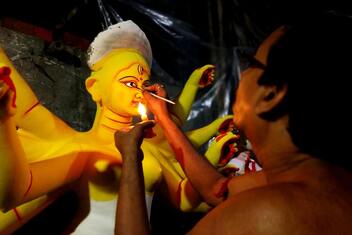 Netronmīlanam is a special ceremony performed as a part of rituals of consecration for Temple mūrtis (icons). Through these rituals, channels are opened to the inner realms and powerful spiritual energies established. A normal space becomes sacred, and mere statues (bimbas) or paintings / images (citrapaṭa) becomes sacred embodiments for Divine shakti. Prāṇapratiṣṭhā is the name for the “life-giving” ceremony through which a mere stone statue, called a bimba, becomes a living, breathing, icon, called a vigraha or mūrti. 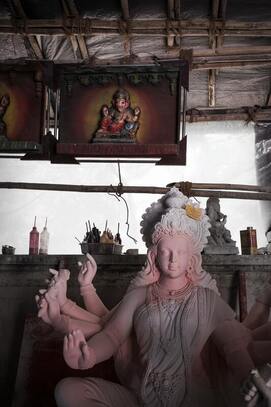 The word idol is often used to describe these sacred temple images. This word was introduced along with its many negative connotations by Christian missionaries with the intention of weakening the Hindu traditions. Vigrahas are not idols, because idol worship implies that people are worshiping something less than God as God. Hindu theology teaches that God pervades all of creation. Sacred temple images are not viewed as God, but a point of focus for people’s prayers and meditations, and also powerful sacred object which hold spiritual energy and act to help open channels to the inner realms for the Devas (Gods / Angelic beings) to confer blessings upon souls in the physical realm. They are created with special imagery which uplifts human consciousness toward righteous thoughts and deeds which help bring about spiritual awareness. If we must use an English word to describe vigrahas in Temples, the word icon, which is also used by Christians for sacred images, is more appropriate. Kumbhābhiśekam is the name for the ceremonies conducted to empower sacred images. Water is placed along with herbs and gems in sacred water pots called kumbhas. They Lord is worshiped in the waterpot, and through this process the water becomes imbued with Divine shakti (energy). Special maṇḍalas (mystical diagrams) are drawn with colored powders and energized with mantras to further empower the process. A series of yajña rituals is performed, offering various herbs, foods, fruits, flowers, ghee, and honey into the sacred fire, to remove negative energies and help manifest spiritual energy which is stored in the water. After the water is energized, it is carried to the Temple with pomp in a procession before being used to bathe the vigrahas. Bathing the deity is known as abhiśekam, and through this process, intense spiritual energy generated through the many rituals is transferred to the Vigraha. Netra means “Eye.” And Unmīlana means “becoming visible, unfolding, or opening of the eyes.” After various rituals to purify the sacred space of the Temple and the images, Netronmīlana homams are performed to prepare for the ritual of Netronmīlanam. The ritual is performed to open channels to the inner realms so that the Devas can see the devotees in the Temple and hear their prayers. It is also performed to heighten the spiritual awareness of the Temple devotees of the sacred presence of the Devas. Normally people have trouble to see the Devas, because they dwell in the inner realms. The Devas likewise have trouble to see and to help the people. There is a veil between realms which obscures communication and interaction. The ritual of Netronmīlanam helps to increase visibility between realms in order to help inform and empower the efforts of the Devas to bless the people, and to increase human awareness of and receptivity to the blessings received.
Learn More About The Netronmīlanam Rituals Contribute to Support our Efforts to Perform Eye-Opening Practices and Ceremonies 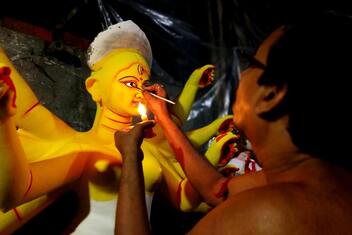 A shilpin (artisan) painting the eyes on a Temple Icon A shilpin (artisan) painting the eyes on a Temple Icon The Netronmīlanam ritual for the deities is performed at an auspicious muhurta (astrological timing). Until this time, the pupils of the eyes of the statues remain uncarved. At the time of the ritual, shilpis (temple stone carvers) carve the pupils, which are then blessed by priests with Vedic mantras for spiritual sight. Painted images, are completed by painting the pupils of the eyes. This process is performed behind a veil so devotees present do not send negative energies through glances (drishti) which could hinder the process. This also helps protect the devotees from the intensity of the ceremony which could stimulate experiences which could be overwhelming. The priests and shilpis are specially trained and prepared to endure the intensity of the rituals. In a small dose, spiritual energy acts like medicine. Like medicine, it can be more like a poison in excess. Just like people have built an immunity to poison by regularly ingesting small doses, the priests and stone carvers expose themselves to intense spiritual energies under the guidance of a guru to acclimate themselves to the intensity so they can endure the powerful rituals for the benefit of humanity. For the ceremony, honey is kept in a golden cup, ghee is kept in a silver cup, and anjanam is kept in a copper cup. Before these substances are placed into the cups, different deities are invoked into the cup and worshiped with various offerings (puja upacharas). The Sun is invoked into the gold cup; the Moon into the silver cup; and Agni into the copper cup. After the vessels are blessed in this way, the honey, ghee, and anjanam are blessed with Vedic mantras and poured into the containers. These substances are then applied to the eyes of the icon at an auspicious moment along with Vedic mantras. Honey is applied with a golden rod with a yellow sapphire (pushparaga) tip. Ghee is applied using a golden (or silver) rod with a diamond (vajra) tip. Anjanam is applied with a gold (or copper) rod with an agate (akik) tip. Consecrated Honey is applied to the right eye with the mantra:
चि॒त्रं दे॒वनां॒ उद॑गा॒-दनी॑कं चक्षु॑र्-मि॒त्रस्य॒ वरु॑णस्या॒ग्नेः। आप्रा॒ द्यावा॑-पृथि॒वी अ॒न्तरि॑क्ष॒ग्ं सूर्य॑ आ॒त्मा जग॑तस्त॒-स्थुष॑श्च॥ ci̱traṁ de̱vanā̱ṁ uda̍gā̱-danī̍kaṁ cakṣu̍r-mi̱trasya̱ varu̍ṇasyā̱gneḥ | āprā̱ dyāvā̍-pṛthi̱vī a̱ntari̍kṣa̱gṁ sūrya̍ ā̱tmā jaga̍tasta̱-sthuṣa̍śca || "The wonderful face of the Gods has arisen; the eye of the Mitra, Varuna and Agni. The Sun has filled the Heaven and the Earth and the middle space, He, the soul and the vision of all that moves and that does not move." -Taittiriya Aranyaka 4.42.5 Consecrated ghee is applied to the left eye with the mantra: तच्चक्षु॑र्-दे॒वहि॑तं पु॒रस्ता च्चु॒क्रमु॒च्चर॑त्। पश्ये॑म श॒रद॑ श॒तं जीवे॑म श॒रद॑ श॒तं नन्दा॑म श॒रद॑ श॒तं मोदा॑म श॒रद॑ श॒तं भवा॑म श॒रद॑ श॒तं शृणुया॑म श॒रद॑ श॒तं प्रब्र॑वाम श॒रद॑ श॒तं अजी॑तास्याम श॒रद॑ श॒तं। ज्योक् चा॒ सूर्यं॑ दृ॒शे॥ taccakṣu̍r-de̱vahi̍taṁ pu̱rastā̎ ccu̱kramu̱ccara̍t | paśye̍ma śa̱rada̍ḥ śa̱taṁ jīve̍ma śa̱rada̍ḥ śa̱taṁ nandā̍ma śa̱rada̍ḥ śa̱taṁ modā̍ma śa̱rada̍ḥ śa̱taṁ bhavā̍ma śa̱rada̍ḥ śa̱taṁ śṛṇuyā̍ma śa̱rada̍ḥ śa̱taṁ prabra̍vāma śa̱rada̍ḥ śa̱taṁ ajī̍tāsyāma śa̱rada̍ḥ śa̱taṁ | jyok cā̱ sūrya̍ṁ dṛ̱śe || "May we see and adore the Sun, who is like an Eye which looks after the welfare of the Celestials. May my eyes, ears, tongue and other organs reveal Divine truth for a hundred years. May I not be helpless and dependent in this time. May I live a hundred years joyous and free from disease. May we see this Divine light (of the Sun) for a hundred years. " -Taittiriya Aranyaka 4.42.5 Consecrated collyrium is applied to both eyes with the mantra: हिरण्यगर्भः समवर्तताग्रे भूतस्य जातः पतिरेकासीत । स दाधार पृथ्वीं ध्यामुतेमां कस्मै देवायहविषा विधेम ॥ hiraṇyagarbhaḥ samavartatāgre bhūtasya jātaḥ patirekāsīta | sa dādhāra pṛthvīṃ dhyāmutemāṃ kasmai devāyahaviṣā vidhema || "In the beginning arose the golden seed; born, he was the sole lord of every creature. He upheld this earth and Heaven(. Which deva (except him) shall we worship with offering?" -Taittiriya Aranyaka 4.1.8 |
Soma Matha BlogSharing news, articles, teachings, and events. Archives
September 2023
Categories |






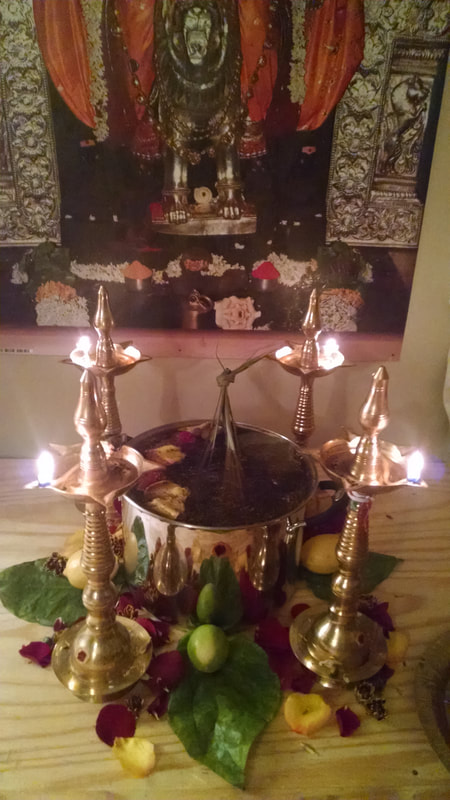

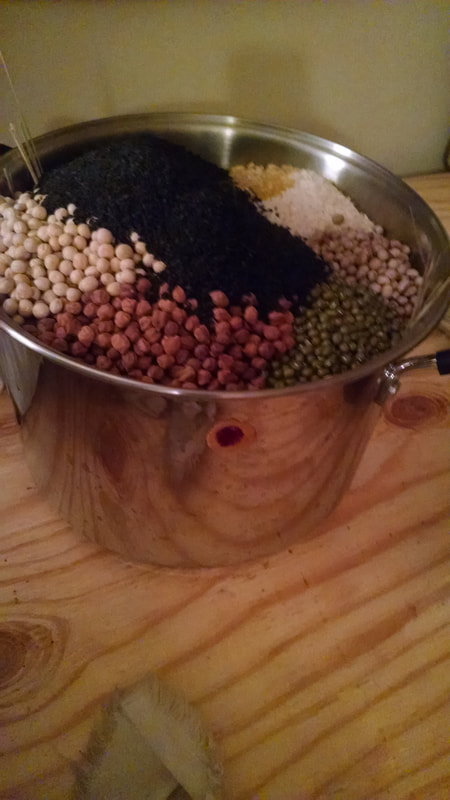


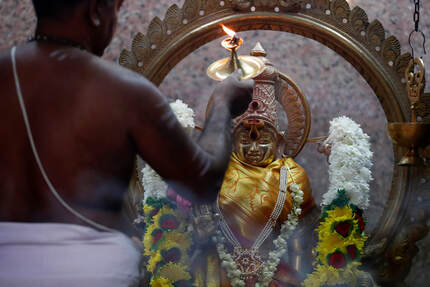

 RSS Feed
RSS Feed